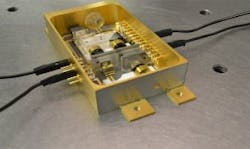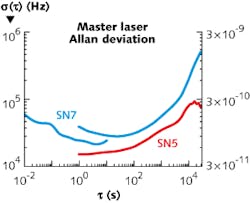With U.S. Defense Advanced Research Projects Agency (DARPA) and Air Force funding, Vescent Photonics (Denver, CO) has simultaneously shrunk the size and power consumption of tunable diode lasers specifically targeted for atomic, molecular, and optical (AMO) physics applications. Unlike laser systems with ancillary optics that require footprints of thousands of cubic inches, the agile-wavelength laser (AWL) optical head contains dual, stabilized diode lasers in a package with a volume of less than 3 cubic in. The head includes an onboard atomic frequency standard (a rubidium saturated-absorption cell) and the electro-optics necessary to slave one laser to the other with a user-defined offset.
The AWL lasers are centered at 780 nm for the D2 lines of rubidium with a tuning range >9.5 GHz and produce more than 5 mW of fiber-coupled light output. Future models will address the D1 lines at 795 nm as well as either the D2 or D1 lines of cesium at 852 and 895 nm, respectively. The master source is referenced to an atomic rubidium transition for absolute accuracy of better than 100 kHz over a 1 s time period. Furthermore, the AWL integrated control electronics (ICE) module shrinks the typically thousands of cubic inches needed for other laser-control platforms to a board-level package with a volume of less than 50 cubic in. Meeting or exceeding the performance parameters of larger lasers, AWL devices cool or probe rubidium atoms and allow manufacturers and scientists to deploy stable optical reference frequencies and cold atoms in true field conditions for applications in gravimetry, magnetometry, GPS-denied navigation, high-speed communications, quantum computing, and cryptography. The AWL systems also provide sufficient fiber-coupled power to seed an optical amplifier for higher-power applications. Contact Michael Radunsky at [email protected].
Sponsored Recommendations
Sponsored Recommendations
Request a free Micro 3D Printed sample part
April 11, 2024
How to Tune Servo Systems: The Basics
April 10, 2024
Voice your opinion!
Voice your opinion!


